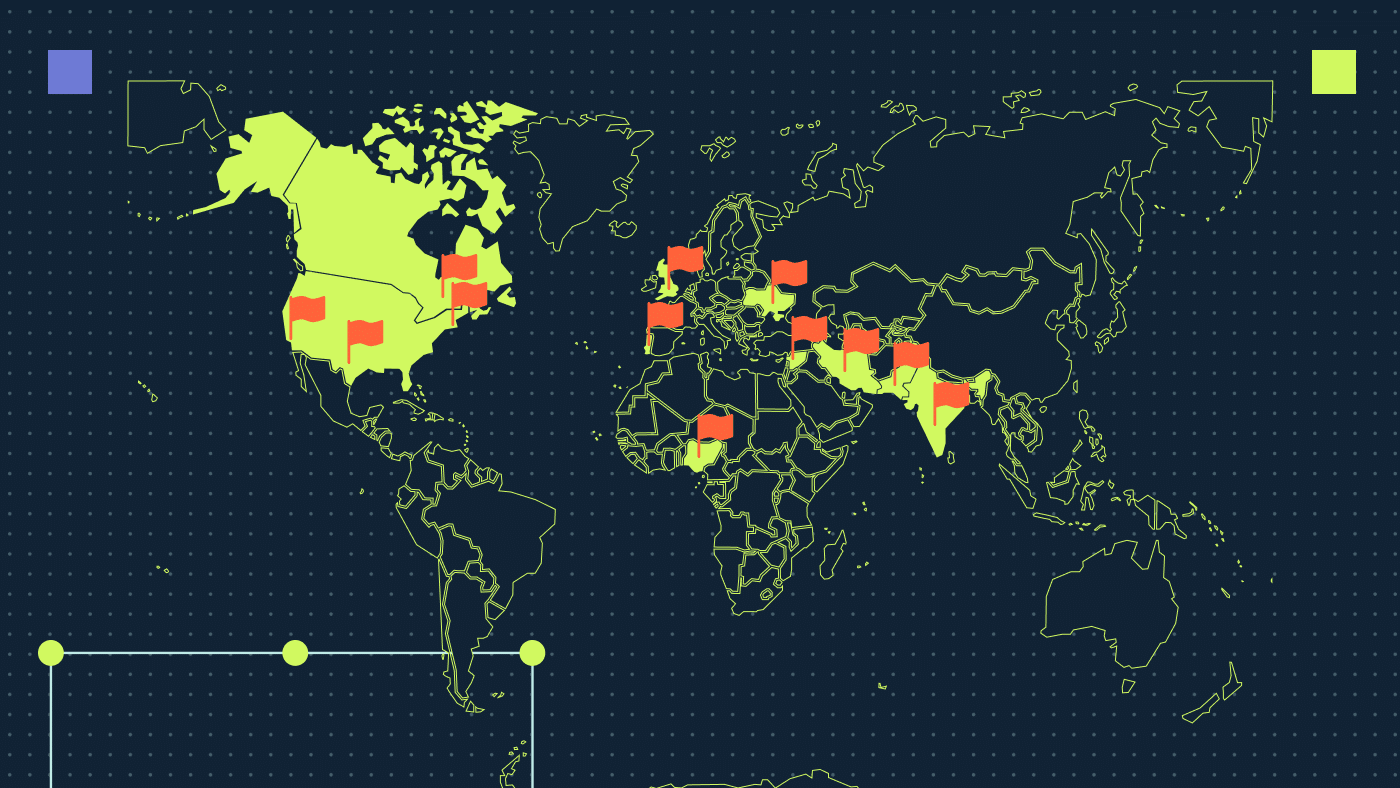International search engine optimization (SEO) is critical for any business that is operating in more than one country. Optimizing your website for a global audience helps boost engagement and traffic.
What is international SEO?
International SEO is a list of best practices used to ensure that your website ranks for search engines in multiple countries and often in multiple languages.
Keep in mind that the vast majority of places in the SERP are occupied by pages that correspond to the language in which the search query was specified. If you want to reach searchers, for example, in France, then without a French version of your site, this will be, to put it mildly, difficult to do (read as impossible).
Who needs an international SEO strategy?
International SEO is a strategy you can use for any type of project if you want to deliver your content, products or services in different languages or/and different countries. But it’s inevitable for websites in countries with more than one official/popular language.
If you have enough resources to implement global SEO correctly, you can significantly increase your overall organic traffic, which can be a pivot moment for your business. However, if it’s done poorly, it will bring you money loss and potential problems with duplicate content. So it’s only for you to decide.
Why international search engine optimization matters
Implementing all international SEO recommendations requires a significant amount of SEO, dev and content team hours. I know what you’re thinking: hours that you could spend on many other important initiatives. So why choose to do global SEO instead? To dominate multiple different markets with little serious competition.
When executing an international SEO strategy, your largest potential expense will be with website translation. If your product has demand in other countries, then this cost will be negligible in the long run as you open yourself up to a much wider market.
Let’s take a look at the traffic sources of Exclaimer.com. To expand their reach beyond the US and the UK, they implemented international SEO on their website to target other English speaking countries — as well as Europe. Now only 24% of their traffic comes from the US and 13% from the UK. The vast majority comes from France, Germany, the Netherlands and Italy.
Local SEO vs international SEO: What is the difference?
Long story short, local SEO and international SEO have nothing — I mean NOTHING — in common. You can implement both strategies at the same time. Or just one of them. Or neither. These two approaches are from different SEO planets.
Here’s why.
Local SEO is one part of the optimization process oriented toward increasing the visibility of the business on keywords for which the user’s physical location is explicitly or implicitly important. It’s critical to local businesses but also an option for almost any web project with a physical address to receive a physical letter from Google.
A big part of local SEO is optimizing your Google Business profile, and most of the effort you can make in these fields is part of an off page optimization strategy.
International SEO best practices
Here’s my seven-step guide on how to do international SEO effectively.
1. Choose the right URL structure
The structure of the URL should be intuitive for you, users and search engines. Let’s look at the possible options for organizing your multilingual content. Google actually explained all the pros and cons of each approach in their managing multi-regional sites guide. But let’s review their recommendations:
Country-specific domain (ccTLD)
Example: website.fr
Pros:
- Looks clean and simple.
- Google loves country-specific domains, and you will rank faster in a new location.
- Easy to analyze because it’s a separate website.
Cons:
- Your domain name may already be occupied.
- It’s an entirely different website. You will have to start all your SEO from the very beginning. If you are investing money in link building, you will have to spare a separate budget for each location/language.
Subdomains with gTLD
Example: fr.website.com
Pros:
- It’s pretty much the same as having a country-specific domain but without a boost to rankings.
- The subdomain name is likely available.
Cons:
- Again, in the eyes of search engines, it will be a separate website so you will have to start all your SEO from scratch.
Subdirectories with gTLD
Example: website.com/fr/
Pros:
- Easy to set up and maintain.
- Link juice is floating through all the inner pages of your website so your language version will get all the benefits of your domain.
- You can apply the geo-targeting to subdirectories — as you would do for a domain or subdomain.
Cons:
- Single server so you will most probably need to use CDN to ensure your visitors get the content fast enough.
- You have to be sure you signal Google about it with hreflang tags.
This is personally my favorite approach. Minimum effort with maximum benefit.
URL parameters
Example: website.com?geo=fr
This is the worst possible way you could have an alternative language page. Since it is not a separate URL, Google will not see the translated content so you will receive no SEO benefit whatsoever.
☝️Bottom line here: there’s no perfect solution. Each approach has its own pros and cons, and you should make a decision based on your resources — aka what your dev team already launched on production and what you have to deal with.
2. Use hreflang tags
After you finally know what your URL will be you’re almost done. Unfortunately, you will have to tell Google about your multiple languages in about three different ways. I recommend you read Google’s documentation about localized versions of your website as well.
Top three ways to use hreflang
1. HTML tag
Put <link rel=”alternate” hreflang=”lang_code”… > in your page’s header to tell Google about the different languages and regions for your page. This is the first and most common way to signal to Google that you have multiple language versions.
For each page version, add <link> tags in the <head> section. Make sure every version has a link, including itself. Keep the link set the same for all versions.
This is how you write each link:
<link rel=”alternate” hreflang=”lang_code” href=”url_of_page” />
Explanation:
“lang_code” stands for a supported language or region code targeted by this page version, or “x-default” for any language not listed by an hreflang tag.
“url_of_page” refers to the full URL for this page version in the specified language/region.
Place your <link> tags at the top of the <head> section. At the least, <link> tags should be in a proper <head> section or before any items that might close the <head> like <p> or a tracking pixel. Use an HTML validator to make sure links are in the <head> section.
Example:
IBM operates a website that caters to users in the US, UK, and France. Here are the URLs with the same content but with regional and language variations:
- https://www.ibm.com/us-en/ – US homepage with content for an American audience.
- https://www.ibm.com/uk-en/ – UK homepage with content for UK audience.
- https://www.ibm.com/fr-fr/ – French homepage with content for French audience.
- https://www.ibm.com/ – The global homepage where users can choose their country and language.
Remember, Google doesn’t use the language-specific URLs (us-en, uk-en, fr-fr) to identify the target audience. You must clearly specify it with hreflang tags.
The HTML below should be in the <head> section of all pages listed above. It directs to the US, UK, French, and all other versions of the page:
<head>
<title>IBM</title>
<link rel=”alternate” hreflang=”en-us” href=”https://www.ibm.com/us-en/” />
<link rel=”alternate” hreflang=”en-gb” href=”https://www.ibm.com/uk-en/” />
<link rel=”alternate” hreflang=”fr-fr” href=”https://www.ibm.com/fr-fr/” />
<link rel=”alternate” hreflang=”x-default” href=”https://www.ibm.com/” />
….
</head>
All hreflang tags from www.ibm.com:

2. HTTP headers
HTML tag hreflang is the most common approach but you can also use HTTP headers.
3. Sitemap
You should also use your sitemap to tell Google that you have alternative language versions of a page. All you have to do is add a <loc> element followed by the original untranslated URL and then add <xhtml:link> child elements with the translated URLs. You can read more about this process in Google’s documentation.
☝️Bottom line here, Google says that using any of these three approaches will be enough for it to understand that your pages have an alternative language/regional versions so you can use any of them.
3. Localize your content
Alright, tech aficionados, if you’ve hung around this far, kudos! Now buckle up because we’re diving deep into translation quality.
Subpar translations? They’re the Achilles’ heel of international SEO. Google boasts about spotting auto-translated gibberish with an eagle eye, and let’s face it, we’re not about to challenge that claim. Even if you sneak past the Google bot, sharp-eyed users won’t be fooled. A wonky translation will drag down your precious conversion rates.
But here’s a pro tip: Start with auto-translating just the basics. Think navigation and CTAs. Then, get a freelancer on board to fix the blunders. It’s a neat hack to get the ball rolling, but if global dominance is on your roadmap, top-tier content isn’t just nice to have, it’s mission-critical.
👉Here’s how to avoid the sloppy writing errors that can hurt your rankings and brand reputation.
4. Execute keyword research for each language/market
It’s not necessary to conduct keyword research for a new market because you’ve already done it for your main language (I hope so). So at the beginning, it’s totally fine to copy your current website structure and translate it. Tips here is to find the right equivalents for your keywords. Direct translation might not always work the best. For example:
English keyword: Cell Phone
Direct French translation: Téléphone cellulaire
While “téléphone cellulaire” is a technically correct translation, it’s not the most commonly used term in France.
More appropriate French equivalent: Mobile or téléphone portable
In France, people more commonly refer to cell phones as “mobile” or “téléphone portable.” Using “téléphone cellulaire” for SEO purposes in France would likely generate fewer hits compared to “mobile” or “téléphone portable.”
5. Use a CDN
A Content Delivery Network (CDN) is a network of servers placed across various locations. Its main role is to distribute the content of a website to users in a more efficient way.
Here’s why a CDN is important for international SEO:
- Page speed: Websites should load quickly everywhere, not just in one country. A CDN ensures that users from various global locations access your site at a fast pace, preventing delays.
- Bounce rate reduction: When a site takes ages to load, users tend to leave. A high bounce rate negatively impacts your rankings. A CDN keeps the site speed optimized, helping retain the users and, thereby, keeping the bounce rates low.
6. Respect cultural differences
In what might initially seem counterintuitive, the reality is that search behaviors for identical products vary significantly across countries.
Take the real estate sector, for instance. In Thailand, the predominant search traffic centers on specific condominium names. Meanwhile, in Kyrgyzstan, potential buyers often begin their search with construction companies. In Ukraine, the primary source of traffic is driven by generic, non-branded keywords. That’s why a thorough analysis of competitors in each market is imperative.
7. Leverage effective link-building tactics for international SEO
Links are a big deal in SEO. Think of them like a thumbs-up from other websites. Even if Google says not to go out and make a bunch of links, there are smart ways to get good links. It’s better to have one great link than ten okay ones. Imagine if a popular website with lots of visitors linked to you. That’s way better than ten small sites no one really visits. Be careful of random people on LinkedIn trying to sell you links, they are not your bros no matter what is in the message.
For websites that want to be popular in different countries, where your links come from matters. If you get many links from French websites, Google thinks users from France like your site. So your site might show up more for users in France. Local links are super helpful. The key is not to try everything. Find out what works best for each country and do more of that.
International SEO with different services and CMS platforms
Understanding how various services and content management systems (CMS) aid in international SEO is pivotal for businesses aiming to expand their global reach. Here’s how to leverage popular tools for this purpose:
Moz
Moz offers a suite of tools beneficial for global SEO:
- Keyword Explorer Tool identifies high-traffic keywords for specific countries and languages.
- Rank Tracker monitors your global rankings for specific keywords across different search engines.
- Link Explorer assesses the quality and quantity of backlinks, particularly from international sources.
- On-Page Grader optimizes content according to the requirements of specific target regions.
- MozBar gives you insights about domain authority, page authority and other key metrics for various regions.
Ahrefs
Ahrefs is another comprehensive toolset for SEO professionals:
- Keywords Explorer enables you to check out search volume and keyword difficulty for different countries.
- Site Explorer analyzes global backlink profiles to see where your competitors are getting international links.
- Rank Tracker monitors global rankings and compares how you’re performing across different countries.
- Content Explorer identifies top-performing content in specific countries, which can inspire localized content strategies.
- Site Audit ensures that hreflang tags and other global SEO elements are correctly implemented.
Semrush
These tools and features from Semrush can be used specifically for international SEO:
- Keyword Magic Tool helps users to research keywords for different geographical locations and languages.
- Position Tracking Tool monitors daily ranking positions for any location.
- Backlink Analytics Tool reviews your website’s backlink data and target global link-building strategies.
- Site Audit identifies technical issues related to global SEO, such as hreflang tag mistakes.
- Market Explorer helps you understand the competitive landscape in different countries.
WordPress
WordPress is one of the most popular CMS platforms and offers international SEO solutions:
- Multilingual plugins like WPML and Polylang allow you to create a multi-language website.
- Hreflang tags can be implemented with plugins such as Hreflang Flag, guiding search engines on language targeting.
- SEO plugins: Plugins like Yoast SEO provide guidance on optimizing content for different languages and regions.
- Localized Themes: Many WordPress themes are translation-ready, enabling easy localization.
Joomla
Joomla provides features and extensions to assist in international SEO:
- Multilanguage feature lets you set up Joomla websites in multiple languages.
- Falang extension helps you to overcome the limitations of Joomla’s core multilanguage feature and manage translations seamlessly.
- OSMap creates XML sitemaps that can include hreflang tags for multilingual sites.
- SEO extensions like EFSEO help optimize meta information for multiple languages.
Drupal
Drupal offers modules and features for implementing an international SEO program:
- Drupal multilingual modules provide comprehensive capabilities to build multilingual sites.
- Hreflang module allows for the easy implementation of hreflang tags.
- Pathauto helps to generate URL aliases for multiple languages.
- Search API improves search capabilities for multilingual sites.
Whether you’re using a service or a CMS, you should focus on creating genuine, localized content for your audience, backed by solid technical SEO. These tools greatly aid in this process, ensuring that your international audience finds you, understands you and engages with your content.
Ready to undertake a global SEO project?
Navigating the vast realm of international SEO is not a task for the faint-hearted. Yet, with the right strategies, tools and platforms, it’s an endeavor that promises significant rewards. Remember:
- Understand and respect cultural nuances; it’s not just about translation.
- Leverage powerful SEO tools to streamline and enhance your efforts.
- Choose platforms that support and simplify your global SEO tasks.
- Avoid common pitfalls and always keep learning. The digital world is ever-evolving, and so is the field of international SEO. Stay updated, stay relevant.
If you need help with your international SEO efforts, give us a shout.






